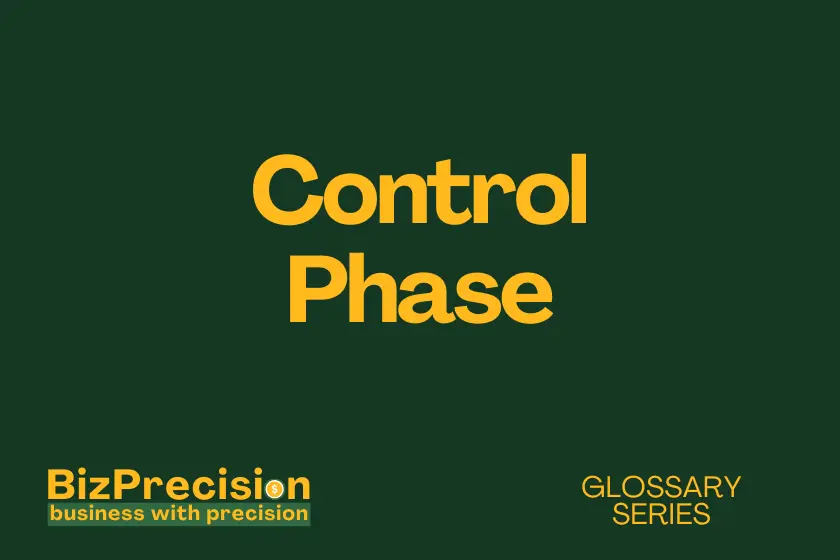What is the Control Phase?
The Control Phase is the final stage of the Six Sigma DMAIC process that ensures lasting process improvements through monitoring and maintenance systems.
This essential phase helps businesses maintain their hard-won process gains. Your teams track performance and respond to issues before they grow.
According to the International Journal of Lean Six Sigma (2023), organizations using robust Control Phase practices see 42% better sustainability of their process improvements. This translates to significant long-term cost savings.
Let’s explore how you can use the Control Phase to lock in your business improvements for good.
Understanding the Control Phase Fundamentals
Key Components of the Control Phase
The Control Phase rests on three main pillars: monitoring, documentation, and response systems. Each part plays a vital role in your success.
Your monitoring systems track key metrics daily. This helps catch issues early before they affect quality. Regular checks keep your processes running smoothly.
Clear documentation guides your team’s actions. Written procedures remove guesswork from daily tasks. This leads to consistent results across shifts and locations.
Response plans tell teams what to do when problems arise. Quick action prevents small issues from growing bigger. This helps maintain quality standards even when challenges pop up.
Control Phase Timeline and Implementation
Most Control Phase setups take 4-6 weeks to complete. This gives teams time to learn new methods properly.
Week 1 focuses on setting up tracking systems. Your team picks the right metrics to watch. They also create simple ways to record data.
Weeks 2-3 involve writing clear process guides. Teams document each step of the improved process. They test these guides to ensure they work well.
The final weeks center on training and testing. Staff learn the new procedures thoroughly. Practice runs help work out any remaining issues.
Role of Control Phase in Six Sigma DMAIC
The Control Phase completes the DMAIC cycle. It turns temporary fixes into lasting gains. This phase protects your investment in process improvement.
Think of DMAIC as building a house. The first four phases lay the foundation and build the structure. The Control Phase adds the roof that protects everything below.
This phase also sets up future improvements. Good control systems show where to focus next. They help teams spot new chances to get even better.
Implementing Effective Control Measures
Control Phase Tools and Techniques
Statistical Process Control (SPC) charts track performance over time. These visual tools help spot trends quickly. Your team can respond before small shifts become big problems.
Standard operating procedures (SOPs) guide daily work. Clear steps help teams maintain quality. Pictures and diagrams make these guides even more useful.
Mistake-proofing tools prevent common errors. Simple changes to equipment or procedures block wrong actions. This makes it easier to do things right the first time.
Documentation and Standard Operating Procedures
Good SOPs use clear, simple language. Short sentences help readers understand quickly. Pictures show exactly what to do.
Update your SOPs when processes change. Regular reviews keep documents current. This helps teams follow the latest best practices.
Electronic systems make SOPs easy to access. Teams can find the right guide quickly. This speeds up training and daily work.
Training and Knowledge Transfer
Effective training uses hands-on practice. Teams learn by doing real tasks. This builds confidence and skill.
Create training checklists for new staff. Track progress through each learning step. This ensures complete coverage of all key points.
Pair new workers with experienced staff. Mentors share practical tips and tricks. This speeds up the learning process.
Monitoring Systems and Response Plans
Set up daily check points in your process. Regular reviews catch problems early. This prevents small issues from growing.
Create clear response plans for common issues. Teams know exactly what to do. Quick action keeps processes running smoothly.
Use automation where possible for monitoring. Electronic systems flag problems instantly. This helps teams respond faster.
Measuring Control Phase Success
Key Performance Indicators (KPIs)
Track process performance daily. Compare results to target ranges. This shows if controls work well.
Watch for trends in your data. Gradual changes may signal future problems. Early action prevents bigger issues.
Share KPI results with your team. Regular updates keep everyone focused. This builds commitment to quality goals.
Long-term Impact Assessment
Review performance quarterly. Look for lasting improvements. This proves your controls work well.
Compare current results to past data. Track the size of improvements. This shows the value of your control system.
Calculate cost savings from better quality. Share results with leadership. This helps get support for future projects.
Continuous Improvement Integration
Link control systems to improvement efforts. Use data to spot new opportunities. This keeps your process getting better.
Hold regular review meetings with teams. Discuss what works and what needs help. This keeps everyone focused on improvement.
Update controls as processes change. Keep systems current with needs. This maintains their effectiveness.
Conclusion
The Control Phase turns process fixes into lasting gains. Good control systems protect your improvements. They help teams maintain quality day after day.
Start building your control system today. Focus first on clear procedures and good training. Add monitoring tools to catch problems early.
Remember, strong controls lead to consistent quality. Your investment in the Control Phase pays off through better results. Take action now to lock in your process gains for good.







